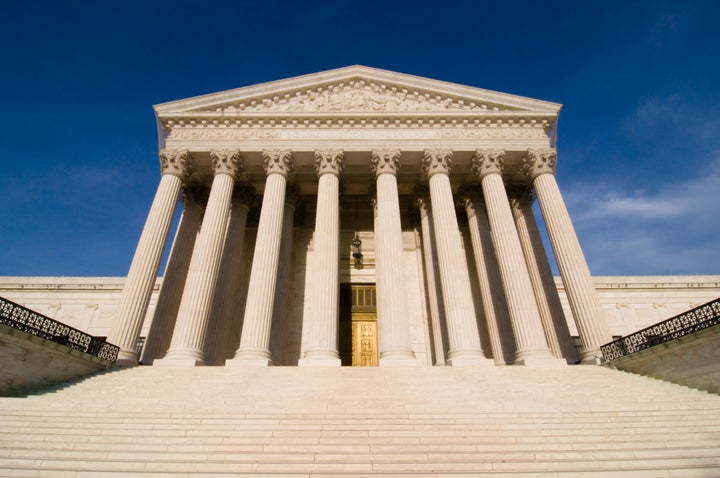
The Wall Street Journal ran a long and thoughtful but fundamentally mistaken editorial today urging the Supreme Court not to pre-empt the evolving cultural debate over same-sex marriage once it hears oral argument on the issue over the next two days. Stepping back from most of the more technical issues before the Court, the editorial sets its focus from the start by saying that the two cases before the Court, Hollingsworth v. Perry and U.S. v. Windsor, "are less about the institution of marriage than the sanctity of democratic institutions and the proper role of the courts." And it concludes:
The Supreme Court does not have a good record legislating cultural change. A ruling on behalf of same-sex marriage could enshrine Hollingsworth and Windsor with Roe v. Wade, the 1973 abortion decision that imposed a judicial diktat even as laws in many states were liberalizing.
That is certainly true of Roe, and for good reason. But those reasons clearly distinguish Roe from the cases now before the Court. In fact, if politics is the issue, a far better analogy with the present cases is the Court's 1967 decision in Loving v. Virginia, which found Virginia's anti-miscegenation law, and those of 15 other states, unconstitutional under the Equal Protection Clause of the 14th Amendment. There, too, we had a controversial decision, handed down at the height of our civil-rights strife. But it did not lead to the unending controversy that has followed Roe, even though it was the Court, not state legislatures, that finally brought an end to laws banning inter-racial marriage.
One reason that Loving did not play out as has Roe is because the nation was more clearly moving in the direction of accepting interracial marriage than abortion, much as today we see a similar movement regarding same-sex marriage. Ironically, in invoking political considerations by way of urging "judicial restraint," the Journal is asking the Court to consider matters that are not, strictly speaking, the proper business of the courts.
But there are also clear substantive differences between today's cases and Roe, which go even further to making Loving a far better analogy. In particular, as in Griswold (1965), upholding the right to sell and use contraceptives, and Lawrence (2003), upholding the right to engage in homosexual sodomy, the statute under challenge in Loving, like that in Hollingsworth, had nothing to do with protecting anyone's rights. Enacted under the state's police power, it sought simply to protect "morals" -- the morals of a portion of the community -- but at the expense of the plaintiffs' rights. In Roe, by contrast, that was hardly the case. Indeed, the very question before the Court was whether the Texas statute was designed to protect rights, the rights of an unborn child. That's why Roe, unlike those other decisions, is still controversial and still vexing the nation.
Moreover, Roe, unlike Hollingsworth or the other cases, did not involve a straightforward up-or-down rights question. Rather, as in such contexts as nuisance and risk, where a line must be drawn between competing right claims, Roe, too, raised the question of where to draw the line between the claims of the child and those of the mother; or, to put it in police-power terms, at what point in the nine-month gestation period does abortion become murder? And on that question, reasonable people can reasonably disagree, which is why in Roe, unlike in the other cases, we had a genuine legal question of "evolving social values" that should properly have been left to the people to decide, state-by-state, since the general police power belongs to the states, not to the federal government. (I have discussed this issue more fully, interestingly, in the Wall Street Journal.)
Unfortunately, the Journal draws none of those distinctions. And when the editorial turns to the equal protection arguments, it simply follows the Court's seriously mistaken jurisprudence, starting with the idea that the Court, depending on the issue before it, should indulge different "levels" of scrutiny, and continuing with the idea that equal protection is about "classes" to be differently protected -- "strict scrutiny" for laws implicating race, "intermediate scrutiny" for laws implicating gender, "rational basis scrutiny" (perhaps) for laws implication sexual orientation, and so forth:
The Court has not used the equal protection clause to create a new category of people who need extra legal defenses in three decades, largely because doing so disrupts the ebb and flow of the ordinary political process. Such caution is prudent, especially here. Homosexuals are not disenfranchised like blacks in the mid-20th century, as the very progress of the gay rights movement shows.
That gets equal protection analysis exactly backwards. It presumes that the government may act -- the political process may ebb and flow -- unless there is some reason why some special class of people needs special protection. In truth, principled equal protection starts at precisely the other end, not with government's power but with the individual's right -- with the idea that we're all equally free. And it continues by recognizing that because government belongs to all of us, it must treat us all equally -- unless there is some serious, compelling reason to do otherwise, to draw distinctions among us. That gets the presumptions and the burdens right. The presumption is on the side of liberty. The burden is on government to justify restricting that liberty. It is a mere historical accident that courts have taken a class-based approach to equal protection. It is no part of the principle of the matter.
All of which can be seen when the Journal continues:
The Court ought to conclude on the merits that marriage as historically understood does have a "rational basis." This version of the equal protection test properly defers to the deliberative judgment of voters and their elected representatives. Traditional marriage laws may support legitimate goals like promoting intact, reasonably stable wedlock between mothers and fathers for children, or simply stem from a desire to not experiment with a core unit of civil society.
The question, however, if equal protection analysis is done properly, is not whether marriage has a rational basis but whether government discrimination against some of those who want to marry has a rational basis. Once the presumption is properly reversed and the matter properly put, the question then becomes, what is a "rational basis" for the government's so discriminating? Unfortunately, under the Court's modern equal protection jurisprudence, unless a plaintiff is seen as a member of a "protected class," any "conceivable reason" will do -- like those just mentioned, purporting to support traditional marriage (and exclude same-sex marriage). Regrettably, the history of such "rational basis" review -- of judicial deference "to the deliberative judgment of voters and their elected representatives" -- is one of majoritarian and, more realistically, special-interest tyranny, conjoined with ever diminishing liberty in countless areas of life.
It is troubling that the same-sex marriage issue has led the Journal to subscribe to the mistaken jurisprudence that it so often rightly and powerfully condemns in those other areas, as when economic liberties are in the government's crosshairs. Liberty is of a piece. The simple presumption of our Constitution is liberty, with government authorized and empowered to protect it, and obligated to offer compelling reasons for restricting it when that should be necessary. In recognizing rights, the Court is not "creating" them. It's simply acknowledging that they were always there, even if we haven't always lived up to our principles and recognized them, as clearly we have not. That's not judicial activism. It's simply the Court engaged in making explicit what was always implicit, even if we haven't seen the matter clearly until now.
Roger Pilon is vice president for legal affairs at the Cato Institute and director of Cato's Center for Constitutional Studies.
